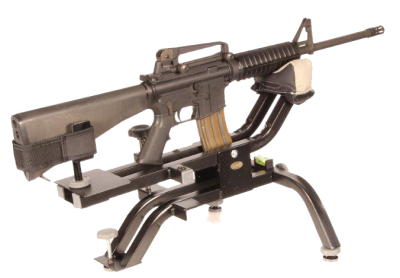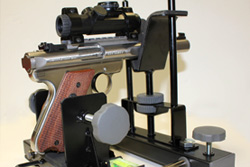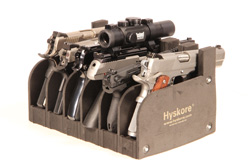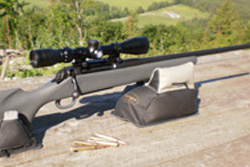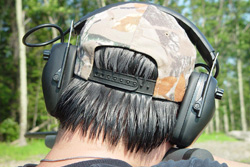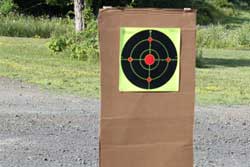HYSKORE® IS THE PREMIER SUPPLIER OF QUALITY RIFLE RESTS AND SHOOTING RESTS.
WELCOME TO HYSKORE.COM
HYSKORE® is the premier supplier of quality compression dampened rifle and shooting rests. If your aim is to achieve a tight group without the discomfort of recoil, our compression dampened, Dangerous Game® Machine Rest, Dual Damper Machine Rest, or DLX Precision Shooting Rest are the right choice. Each rifle rest incorporates nitrogen filled compression damper technology to progressively reduce recoil without the addition of any weight.
Our “Track & Elevate” rest adds a whole new dimension to rifle rest innovation. This shooting rest provides effortless traversing, and instant elevation. There is no other rifle rest on the market with these great features.
When it comes to Electronic Hearing Protection, our Over&Out® line offers more features and competitive pricing than other electronic hearing protectors. The lineup includes: the #30150 Dual Control Stereo Unit, the #30063 with user selectable impulse or compression protection, the #30194 AM/FM Radio Protector, and the new #30285 Dual Control, Dual Circuit Stereo unit. If you want the best choose Over&Out®.
In addition to recoil attenuating shooting rests and full featured electronic hearing protection, HYSKORE® offers a full line of space saving pistol racks and handgun storage solutions. Later this year we will introduce our #30259 Competition Range Box constructed from heavy gage diamond plate aluminum.
A WORD ABOUT RIFLE ACCURACY
When it comes to shooting, the word “accuracy” really refers to group size. Once the group is established, adjusting the sights to move the point of impact to the point of aim is a simple task. A gun/ammunition combination that shoots to 1, 3, or 5 MOA is just that. No matter what rifle rest or shooting rest you use to support the gun that group size will not change, not to mention extraneous factors such as sighting device, wind, stability of the shooting platform, trigger pull, parallax and/or the shooter. There is a long list of factors that can affect group size. Below we have attempted to briefly address a few of the more common ones. All comments are made with the “all things being equal” and “under perfect conditions” provisos. Please consider this a general guide that might point out a few things that might not have come to mind. Our #30013 Dangerous Game® Machine Rest, #30003 Precision Rifle Rest, #30088 DLX Precision Rifle Rest and Ten Ring® Shooting Rest are designed to produce repeatable results. If the shooting rests are properly assembled, securely anchored to a bench that is rock solid and does not shift under the stress of recoil, you will be able to maximize repeatability. Each shooting rest will consistently repeat well under 3 MOA. What this means is that if the gun/ammunition combination is capable of shooting groups of less than 3 inches at 100 yards (nominal 3 MOA), you will be able to realize this degree of repeatability with either rifle rest. The big word in the previous sentence is “IF”. No rifle rest will make a 3 MOA gun place all of the bullets in one hole. The group will still be 3 MOA. If your bullets are not all forming a tight group, there is a high probability that the problem is a result of the gun, ammunition and/or the sight.
* MOA – Minute of arc – A circle has 360¡, each degree has 60 minutes, i.e. 1/60th degree. 1.0 MOA is exactly 1.047 inches at 100 yards. Always wear approved eye and hearing protection when using these shooting rests. HYSKORE’s® Over & Out® Electronic Hearing Protection works well.
CENTER FIRE ACCURACY
A large percentage of the rifles, old and new, in the hands of American sportsmen will not shoot much better than 2.5 MOA with exceptional guns shooting 1.0 – 1.5 MOA, (assuming the ammunition is correctly matched to the rifle). The average deer rifle, using popular brand, off the shelf ammunition is probably capable of 2.5-3.0 MOA because the gun and ammunition manufacturers know that a typical white tail is statistically harvested at a range of less than 100 yards, and a gun that places the bullets within 3 MOA will easily place all of them within a heart sized circle. Manufacturing guns and ammunition that will shoot under 1 MOA is, of course, done every day, but there are only a few manufacturers that guarantee that result, and then only with ammunition that they specify. The costs associated with the manufacturing, quality control, and attention to detail, price these guns out of reach of a large part of the market. With that being said, a gun/ammunition combination with 3 MOA accuracy, properly sighted in, will usually get the job done and nobody will know the difference. The target is dead -end of story. The point here is that if your rifle is shooting at or beyond 3 MOA, the issue is, in all probability, a combination, of factors that can affect accuracy. We have prepared a short list of issues you may want to consider in examining the group size of your rifle.
- Bolt action sporting rifles are by nature and design typically more accurate than pump, lever, or semi-automatic rifles. The reason for this is the bolt action tends to be much more rigid, and therefore flexes less. In addition, a bolt action rifle usually has a larger and stronger extraction mechanism, which means the chamber can be made to closer tolerances than other types of actions. Believe it or not, not all ammunition in the same caliber is made to the exact same dimensions by all manufacturers. For example, SAAMI (Sporting Arms and ammunition Manufacturers Institute, www.saami.org publication ANSI/SAAMI Z299-1992) allows a variance of up to -.008 under the standard for diameter, and up to -.007 under for the standard distance from the base to the shoulder (this determines head spacing) for center fire 30-06 ammunition. (Variances across most calibers are similar.) The extraction mechanism in pump, lever, and especially in semi-automatic weapons must be able to consistently and effectively extract cartridge cases at a rate equal to the cyclic rate of the weapon using the entire range of commercially available ammunition. This can be problematic if the cartridge fits too tight in the chamber. As a result manufacturers tend to make these chambers more tolerant of ammunition that may tend towards the larger end of the size range. Conversely, if ammunition manufacturers want their product to function in guns typically in the hands of sportsmen, they must also consider how easily the cartridge seats and extracts. Needless to say, there are exceptions to this, but as a rule as you move away from a precise cartridge chamber fit accuracy suffers. This is especially apparent in military weapons because they must chamber ammunition from various sources (therefore with various tolerances) and must function even if the ammunition is corroded or dirty. Reliability, not pinpoint accuracy is the primary criteria.
- Match the correct bullet weight to the twist of the rifling. This is one of the most commonly overlooked factors that determines group size. If the bullet length and twist rate of the barrel are not synchronized, accuracy will suffer. A 110 grain .308 bullet is, of necessity, shorter than a 220 grain .308 bullet. For proper stabilization the heavier, and hence longer bullet, requires a faster rate of rifling twist than a short, light bullet. Further to this point, different guns respond differently to ammunition from different manufacturers. The point here is that you should test fire ammunition from several manufacturers and select bullet weights that are compatible with the rate of twist of the gun’s rifling. Generally speaking, twist rate is stamped on the barrel or the information is available from the manufacturer. You need to test different bullet weights to optimize results. The following websites will give you more information regarding this issue:
www.snipercountry.com/hotlips/twistrate.htmlwww.uslink.net
kwk.us
en.wilkipedia.org/wiki/rifling
www.gsgroup.co.za/cip.html
CALCULATING TWIST RATE
Legend:
BL = Bullet Length
BD = Bullet Diameter
C = 150 constant for muzzle velocity 1500-2800 FPS
C = 180 constant for muzzle velocity over 2800 FPS
(choose the correct constant for the ammunition you are using)
Formula:
C x BD
BL
BD
First divide the bullet diameter (for example .224) into the bullet length (for example .712). Divide the result into the correct constant (150 or 180) and multiply the result by the BD (for example .224). The results is the approximate minimum twist rate necessary to stabilize the bullet – Remember a 1:9 rate is faster than a 1:14 rate.
Example A: .223 (5.56 x 45) @ 3200 FPS, 52 Grain, BL= .712 BD=.224
180 = 180 = 180 = 56.64 x BD = 56.64 x .224 = 12.7
BL .712 3.178
BD .224
12.7 is the optimum rate of twist
Example B: .223 (5.56 x 45) @ 2500 FPS, 75 Grain, BL= 1.095 BD=.224
150 = 150 = 150 = 30.6 x BD = 30.6 x .224 = 6.86
BL 1.095 4.9
BD .224
6.9 is the optimum rate of twist
If you use the 52 grain bullets in a 7.0 twist barrel the result will be fairly accurate. If you use the 75 grain bullet in a 12.0 or 13.0 twist barrel your group will probably be all over the target.
Diameters of Popular Bullets
.204 – .204 7mm – .284.
.223 – .224 .308 – .308
.243 – .243 .338 – .338
.270 – .277 .375 – .375
Bullet length varies by manufacturer and style. For this information check with the manufacturer or take an actual measurement. Needless to say, using a quality rifle rest or shooting rest to evaluate performance will yield the best results.
A perfectly formed muzzle crown allows the gas to escape in a uniform pattern around the base of the bullet as it exits. Through improper cleaning and handling the crown of the muzzle can be easily damaged. Even a small ding, which may not necessarily be visible to the naked eye, can cause an uneven release of gas, which can heel the bullet over slightly, producing a yaw attitude. This will affect the bullet’s stability and accuracy, as the long axis of the bullet will no longer be coincidental with the path of travel.
The quality of the ammunition you use can have a direct result on repeatable group size; the more consistent the ammunition, and the components from which it is manufactured, the more consistent the results. Several manufactures make match grade ammunition where the components are carefully selected and screened for consistency and conformance to specification. (One of the manufacturers that are best known for achieving the most consistent results is Black Hills www.black-hills.com). There are several other manufacturers that make acceptable match grade ammunition, and there are other options. If you are a re-loader, you are already aware of the range of quality components available and in all probability you are able to produce consistent, high quality ammunition.
# Vertical Grouping – See Rim Fire section point D.
Check Your Scope and Mounting – With older and especially inexpensive scopes it is not uncommon for the reticle to stick or shift, especially under heavy recoil and/or temperature extremes. If this happens your muzzle could end up pointing in a slightly different direction after each shot. To check for this condition, lock the gun in a gun vise that doesn’t move and sight the reticle on a set point/target then use a piece of wood or other object (that will not do damage), to tap the scope tube to imitate recoil. If the reticle moves from the original point of aim, you have a problem with the scope. Also check the scope mounting using the same procedure. Mounts and rings frequently become loose due to recoil and heat. In addition to properly mounting a scope the rings must be lapped and centered otherwise there may not be sufficient contact to secure the scope. Even Locktite doesn’t insure that mounts and rings will not shift under severe recoil.Parallax is the apparent shift of the target relative to the reticle due to the horizontal movement of the observer. Scopes with parallax adjustments must be correctly adjusted. Scopes without a parallax adjustment are gene- rally range specific for parallax free sighting. If you have made the adjustments to eliminate parallax you are good to go. If not, it is important to make sure that the longitudinal optical axis of the scope that runs through the center of the crosshairs is directly aligned with the pupil of your eye. If you have an inconsistent cheek weld to your stock or fail in any other way to address parallax your groups will suffer from horizontal dispersion, i.e.: open up left to right. This will happen because your view of the target in the horizontal plane will vary with each shot.
Barrel temperature plays a major role in maintaining group size. As a barrel heats up torsional stress will cause the barrel to twist. Bench rest shooters wait several minutes between each shot to keep the barrel from overheating. If you fire 10 or 12 shots in rapid succession from a sporter weight barrel your groups will expand.
Other factors, which we will not explore here include: Free floating barrels, bedding, barrel harmonics, etc. – Not to mention the shooter!
RIM FIRE ACCURACY
(Some of this applies to center fire rifles also.)
Accuracy in a rim fire rifle is to a large degree more dependent upon the ammunition as opposed to the equipment. Center fire ammunition can be loaded and/or reloaded to precise and consistent specifications. Rim fire ammunition can only be loaded at the factory level. Since rim fire ammunition is not re-loadable, it is necessary to use whatever is commercially available. Factors affecting rim fire accuracy are:
- As with a center fire cartridge there is a SAAMI specification (ANSI/SAAMI Z 299.1-1992) and variance for the dimensional aspects of rim fire ammunition that allows up to -.004 under the standard diameter for .22 long rifle match or sporting ammunition. Consequently, manufacturers make ammunition within the entire range of this variance. As a direct result a rifle that is expected to perform reliably must be able to accept the full range of available ammunition. What this has led to are guns that are match chambered which are invariably bolt action. (The chambers in these guns have a tight precise cartridge fit and the guns perform best with match grade ammunition that is made to close tolerance), and then we have most other guns that have sporting chambers, many of which are auto loaders. The chambers in these guns must be made large enough so that the gun will cycle correctly with any off the shelf brand of ammunition which could be manufactured to any size within the allowable range of tolerance. i.e., This means the cartridge may fit loosely in the chamber. Due to gravity the cartridge settles into the lowest portion of the chamber. The result is that the center axis of the chamber, and hence the center axis of the barrel is not aligned with the center axis of the bullet. This means that the bullet will engage the rifling off center and will travel down the barrel and exit the muzzle at an angle resulting in a loss of stability and accuracy.
- Concentricity – If the long axis of the bullet is not concentric with the long axis of the case it will also not be concentric with the long axis of the bore, as above the bullet will travel down the barrel and exit the muzzle at an angle with similar results. As little as .002”-.003” off center will cause a noticeable enlargement of the grouping.
- Head Spacing is the distance the bullet must move from the casing until it engages the rifling. In a rim fire this is controlled by the thickness of the rim. According to SAAMI standards rim thicknesses may vary from as little as .036” to as much as .043”. A gun may perform much better with one rim thickness as opposed to others. It therefore important to test your gun with a wide range of ammunition. Typically in a box of inexpensive ammu- nition is you will find a considerable variance in rim thicknesses. This will usually result in expanding the group size; consistency of rim thickness will result in smaller, consistent group sizes. Both concentricity and rim thickness can be measured by using the HYSKORE® #30075 Ammo Analyzer.
- If the group spread is more vertical than horizontal it is usually the fault of the ammunition. At a known distance, a faster bullet reaches the target quicker and drops less, i.e. gravity has less time to act. As you may appreciate, the small quantities of primer and propellant used in a rim fire cartridge must be precisely and accurately measured in order to produce consistent velocity. Only a small variance in absolute terms translates to a significant percentage variation and by extension, variation in velocity. Maintaining this type of consistency across large production runs is incompatible with maintaining low cost. Primer compound has an explosive force in the magnitude of 25 to 50 times that of the propellant. As little as 1/10 grain (1/70,000 lb.) deviation will cause a velocity differential. With these thoughts in mind, the culprit in groups that open top to bottom is almost always inconsistent velocity. The faster bullets strike higher and the slower ones lower.
- Scope Problems – See “F” and “G” under Center Fire.
Generally speaking, recoil is not a factor that affects rim fire rifle accuracy. Using a quality rifle rest or shooting rest will assist in optimizing results.
The aforementioned issues represent a brief synopsis of various conditions that may affect accuracy. There are numerous in depth studies that can provide detailed analysis of each situation. We are not experts and do not intend to be. Our comments and suggestions are the result of studying and compiling data from a wide range of sources. Furthermore, we have only touched on the more significant factors that affect accuracy. If you elect to make adjustments to your gun/ammunition combination to increase accuracy, we suggest that you address each issue one at a time. Do not try to make multiple corrections at the same time as you may contaminate the results, and possibly obscure important issues that need further attention. Also, always use approved eye and hearing protection such as HYSKORE® Over&Out® electronic hearing protection.
CALCULATING RIFLE RECOIL
There are two ways to do this.
- The easy way – go to one of the rifle recoil calculation websites listed in this pamphlet or go to one of the links listed on our website: www.hyskore.com
- If you like playing with numbers, use the following formula. While Isaac Newton or Albert Einstein might take us to task for being off by 2 or 3 %, this will get you into the ballpark and give you a very close approximation of rifle recoil. We have divided the process into 2 steps. First, calculate the recoil velocity then use this information to calculate the recoil energy in ft/lbs.
Legend:
PW – Weight of powder charge
BW – Weight of bullet (grams)
MV – Muzzle Velocity
GW – Weight of loaded gun/w scope
RV – Recoil Velocity
RE – Recoil Energy
- RV = [(1.75 x PW) + BW] x MV
7,000 x GW
Run the calculation like this:
- Multiply the weight of the powder charge PW x 1.75
- Add the bullet weight (BW) to this number (result from A)
- Multiply this number (result from B) by the bullet velocity (MV) – Hold this number aside
- Multiple the weight of the gun (GW) x 7000
- Take the calculation from D (GW x 7000) and divide it into the number you held aside
in C (above) – This is the velocity of the recoil.
- RE= RV2 x GW
64.4
Run the calculation like this:
F. Square the recoil velocity and multiply it by the weight of the gun G. Divide this number (result from F) by 64.4. This is the recoil energy in ft./lbs.
Example: Actual data for .308 Winchester model 70 with 24” barrel & scope.
PW = 40 Grains
BW = 180 Grain (sierra match king)
BV = 2,500 Fps
GW = 8.2 lbs
RV = [(1.75 x 40) + 180] x 2,500 = 625,000
7,000 x 8.2 57,400 = 10.89 fps
RE = 10.89 x 10.89 x 8.2 = 972 = 15.10 ft./lbs.
64.4 64.4
The Recoil Velocity (RV) is 10.89 fps
The Recoil Energy (RE) is 15.10 ft/lbs
A few pointers
- The weight of the gun (GW) should always be in pounds. e.g. 7.3, 8.2, etc.
- The weight of the powder charge has a very small influence on the recoil velocity (RV)
or recoil energy (RE). but must be included in the calculation. If you do not know the exact number, use the flowing guidelines:
.219 – .223 – 25 grains
.22 – 25 – .257 – 38 grains
.264 – .28 – 55 grains
.308 – 30’06 – 45 grains
.300 & 7mm mag – 62 grains
.338 – 70 grains
.375 – 85 grains
.416 – .458 – 110 grains
Do your calculations with 2 or 3 different powder weights and you will see that the recoil energy (RE) only varies slightly. The 64.4 Number is a constant and the 7000 number is the number of grains in one pound.
Remember: if you do something dumb, bad things can happen.
The recoil energy chart in each instruction book is only a general guideline.
For more detailed recoil energy data (as of this writing) there are several good websites that you can reference:
- http://www.shooterscalculator.com/recoil-calculator.php
- http://www.beartoothbullets.com/rescources/calculators/php/recoil.htm
- http://www.jbmballistics.com/cgi-bin/jbmrecoil-5.1.cgi
- http://kwk.us/recoil.html
- http://www.omahamarian.org/trap/shotshellenergy.html
- http://www.cleverinsite.com/ballistics/calcs.asp
or go to our website (www.hyskore.com) click on the image of the Ten Ring®, Dangerous Game® Machine Rest or DLX Precision Shooting Rest then click on the link to the recoil calculator.
The recoil that you feel is a function of the action-reaction created as the bullet moves forward in the barrel and, shortly thereafter, gas exiting the muzzle (Rocket Effect). Therefore, the quantity of propellant in addition to gun weight, bullet weight and muzzle velocity is an important factor in determining recoil energy and recoil velocity. Make certain that this is part of your calculation. Calculate your rifle recoil energy carefully and DO NOT EXCEED THE LIMITS OF THE COMPRESSION DAMPER!
FOR YOUR REFERENCE
Additional manufacturers and models of rifle rests, shooting rests, sighting rests, pistol rests and gun vises include:
Titegroup SDR27 – SDR Stability Designed Rifle and Pistol Rest
Titegroup SDR40 – Rifle and Pistol Rest
Sinclair Basic Shooting Rest
Sinclair Generation II All-Purpose Shooting Rest
Sinclair Generation II Benchrest Shooting Rest
Target Shooting Inc. – Model 1000 Rifle Rest
Caldwell Lead Sled Rifle Shooting Rest
Caldwell Lead Sled DFT Rifle Shooting Rest
Caldwell Lead Sled Plus Rifle Shooting Rest
Caldwell Zero-Max Rifle Shooting Rest
Caldwell 7 Rest Rifle Shooting Rest
Caldwell Rock BR Competition Rifle Front Shooting Rest
Caldwell Rock Deluxe Rifle Front Shooting Rest
Caldwell Rock Jr. Rifle Front Shooting Rest
Caldwell Fire Control Rifle Front Shooting Rest
Caldwell Full Length Fire Control Shooting Rest
Caldwell Steady Rest NXT Rifle Shooting Rest
Caldwell Handy Rest NXT Rifle Front Shooting Rest
CTK Precision P3 Ultimate Shooting Rest
ADG Rifle Shooting Rest
Hornady Delta Rifle Front Shooting Rest
Wichita Arms XBR-1000 Rifle Front Shooting Rest
Ransom Rifle Master Standard Rifle Front Shooting Rest
Ransom Rifle Master Omni Series Plus Rifle Front Shooting Rest
Shooters Ridge Gun Grip Magnum Gun Vise
Shooters Ridge Steady Point Tri-Stance Rifle Front Shooting Rest
Shooters Ridge Steady Point Rifle Shooting Rest
Shooters Ridge Steady Point Pistol Shooting Rest
Shooters Ridge Zero Kick Shooting Rest
Shooters Ridge Steady Point Shooting Rest with Vise
Shooters Ridge Gun Grip Vise
Center Mass Mini-Sharpshooters Rifle Rest
Center Mass Tactical Sharpshooters Rifle Rest
Bench Master Rifle Rests
Coyote Jakes Shoot’n Buddy
Coyote Jakes Shoot’n Buddy II
Cabela’s Premier Rifle Rest
Cabela’s Elite Rifle Rest
Cabela’s Nitro Shoulder Shield Rest
Cabela’s Sharp Shooter Rifle Rest
Cabela’s Granite Bench Rest
Inventive Technology Sharp Shooter Magnum Shooting Rest
BenchBuddy® Gun Rest
Kolpin® Sight Vise
MTM® Shoulder-Gard Rifle Rest
Hughes Range Rest
Sharp Shooter Auto Magnum Rifle Rest
MTM Gun Vise
MTM Pistol Shooting Rest
MTM Predator Rifle Shooting Rest
MTM Site-In-Clean Rifle Shooting Rest
National Match Rifle Rests
Additional Manufacturers and models of Electronic Hearing Protection include:
Caldwell Sound-Right ES-85 Electronic Earmuffs
Caldwell E-Max Low Profile Electronic Earmuffs
Caldwell E-Max Electronic Earmuffs
Caldwell Platinum Series G3 Electronic Earmuffs
Champion Stereo Electronic Earmuffs
Howard Leight Impact Sport Electronic Earmuffs
Howard Leight Impact Sport Electronic Noise Amplification Earmuffs
Howard Leight L3 High Attenuation Noise Blocking Earmuffs
Howard Leight AM/FM Lightweight Protective Earmuffs
Howard Leight R01523 Leightning LOF Earmuffs
Howard Leight AM/FM Lightweight Protective Earmuffs RWS-53005
MSA/Sordin Supreme Pro Electronic Earmuffs
Peltor Tactical 6S Electronic Earmuffs
Peltor Tactical 6S Behind the Head Electronic Earmuffs
Peltor Tactical 7S Electronic Earmuffs
Peltor PTL Push-To-Listen Electronic Earmuffs
Peltor ComTac 2 Tactical Electronic Earmuffs
Peltor Tactical PRO Electronic Earmuffs
Peltor Tactical PRO Behind the Head Electronic Earmuffs
Peltor TacSport Electronic Earmuffs
Peltor Alert AM/FM Earmuffs with Audio Jack
Pro-Ears Pro 200 Electronic Earmuffs
Pro-Ears Pro 200 Behind-the-Head Electronic Earmuffs
Pro-Ears Pro 300 Electronic Earmuffs
Pro-Ears Sporting Clay Gold Electronic Earmuffs
Pro-Ears Stalker Gold Electronic Earmuffs
Pro-Ears Stalker Gold Electronic Earmuffs
Pro-Ears Predator Gold Electronic Earmuffs
Pro-Ears ProSlim Gold Electronic Earmuffs
Pro-Ears ProMag Gold Electronic Earmuffs
Radians Hunter’s Ears Electronic Earmuffs
Radians Pro-Amp Electronic Earmuffs
Radians Pro-AmpBTH Electronic Earmuffs
Radians Sound FX Electronic Earmuffs
Radians Redhawk RH Electronic Earmuffs
Radians Redhawk BT Electronic Earmuffs
Radians Maximus Electronic Earmuffs
Radians Omni Electronic Earmuffs
Remington Electronic R2000 Earmuffs
Silencio Regional 1.1 Communications Receiver Electronic Earmuffs
Silencio Relax AM/FM Electronic Earmuffs
Silencio React AM/FM Electronic Earmuffs
Walker’s Game Ear Electronic with Adjustable Frequency Tuning Earmuffs
Walker’s Game Ear Electronic QUAD Earmuffs




